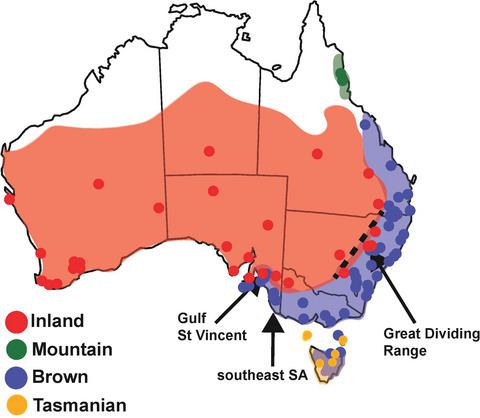当前位置:
X-MOL 学术
›
J. Zool. Syst. Evol. Res.
›
论文详情
Our official English website, www.x-mol.net, welcomes your
feedback! (Note: you will need to create a separate account there.)
Biotic and abiotic drivers of evolution in some Australian thornbills (Passeriformes: Acanthiza) in allopatry, sympatry, and parapatry including a case of character displacement
Journal of Zoological Systematics and Evolutionary Research ( IF 2.0 ) Pub Date : 2020-01-13 , DOI: 10.1111/jzs.12355 Amelia Coman 1, 2 , Sally Potter 1 , Craig Moritz 1 , Catriona D. Campbell 2 , Leo Joseph 2
Journal of Zoological Systematics and Evolutionary Research ( IF 2.0 ) Pub Date : 2020-01-13 , DOI: 10.1111/jzs.12355 Amelia Coman 1, 2 , Sally Potter 1 , Craig Moritz 1 , Catriona D. Campbell 2 , Leo Joseph 2
Affiliation

|
Disentangling historical, ecological, and abiotic drivers of diversity among closely related species can benefit from morphological diversity being placed in a phylogenetic context. It can also be aided when the species are variously in allopatry, parapatry, and sympatry. We studied a clade of Australian thornbills (Passeriformes: Acanthizidae: Acanthiza) comprising the Brown Thornbill (A. pusilla), Inland Thornbill (A. apicalis), Mountain Thornbill (A. katherina), and Tasmanian Thornbill (A. ewingii) whose distributions and ecology facilitate this approach. We first clarified phylogenetic relationships among them and then detected a low level of gene flow in parapatry between a non‐sister pair (Brown, Inland). Further work could partition relative roles of past and current hybridization. We identify likely cases of ecologically driven divergent selection and one of convergent evolution. Divergent selection was likely key to divergence of Inland Thornbills from the Brown–Mountain sister pair. In contrast, convergence in plumage between the non‐sister Brown and Inland Thornbills has been driven by their mesic forest habitats on opposite sides of the Australian continent. Finally, morphological distinctiveness of Tasmanian populations of Brown Thornbills could reflect character displacement in sympatry with the ecologically similar Tasmanian Thornbills. Collectively, the combined morphological, genetic, and ecological evidence points to diverse evolutionary processes operating across this closely related group of birds.
中文翻译:

某些澳大利亚犀鸟(Passeriformes:Acanthiza)的异位,共生和副生进化的生物和非生物驱动因素,包括性格错位的情况
密切相关物种间多样性的历史,生态和非生物驱动因素可以受益于置于系统发育背景下的形态多样性。当该物种在不同的隐匿区,副牧区和交界区中出现各种变化时,也可以提供帮助。我们研究了澳大利亚thornbills(雀形目:Acanthizidae:一个分支Acanthiza),包括布朗Thornbill(A. pusilla),内陆Thornbill(A. apicalis),山Thornbill(A.凯瑟琳)和塔斯马尼亚Thornbill(A. ewingii)的分布和生态学促进了这种方法。我们首先弄清了它们之间的系统发育关系,然后在非姐妹对(布朗,内陆)之间的骨肉中检测到低水平的基因流动。进一步的工作可以划分过去和当前杂交的相对角色。我们确定了生态驱动的趋异选择和趋同进化之一的可能案例。不同的选择可能是内陆犀鸟与布朗山姐妹对分离的关键。相比之下,非姐妹布朗和内陆犀鸟之间的羽毛趋同是由其在澳大利亚大陆相对两侧的林间生境造成的。最后,塔斯马尼亚褐犀鸟种群的形态学独特性可以反映与生态类似的塔斯马尼亚犀鸟共生的字符位移。总体上,形态,遗传和生态学证据的结合指出了在这一紧密相关的鸟类群中运作的各种进化过程。
更新日期:2020-01-13
中文翻译:

某些澳大利亚犀鸟(Passeriformes:Acanthiza)的异位,共生和副生进化的生物和非生物驱动因素,包括性格错位的情况
密切相关物种间多样性的历史,生态和非生物驱动因素可以受益于置于系统发育背景下的形态多样性。当该物种在不同的隐匿区,副牧区和交界区中出现各种变化时,也可以提供帮助。我们研究了澳大利亚thornbills(雀形目:Acanthizidae:一个分支Acanthiza),包括布朗Thornbill(A. pusilla),内陆Thornbill(A. apicalis),山Thornbill(A.凯瑟琳)和塔斯马尼亚Thornbill(A. ewingii)的分布和生态学促进了这种方法。我们首先弄清了它们之间的系统发育关系,然后在非姐妹对(布朗,内陆)之间的骨肉中检测到低水平的基因流动。进一步的工作可以划分过去和当前杂交的相对角色。我们确定了生态驱动的趋异选择和趋同进化之一的可能案例。不同的选择可能是内陆犀鸟与布朗山姐妹对分离的关键。相比之下,非姐妹布朗和内陆犀鸟之间的羽毛趋同是由其在澳大利亚大陆相对两侧的林间生境造成的。最后,塔斯马尼亚褐犀鸟种群的形态学独特性可以反映与生态类似的塔斯马尼亚犀鸟共生的字符位移。总体上,形态,遗传和生态学证据的结合指出了在这一紧密相关的鸟类群中运作的各种进化过程。






























 京公网安备 11010802027423号
京公网安备 11010802027423号